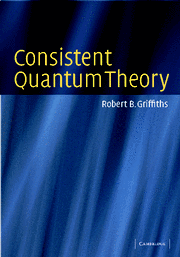Quantum mechanics is a notoriously confusing and difficult subject, which is terribly unfortunate given its status as a fundamental theory of how the world works. When I was an undergraduate and graduate student of physics in the 1980’s, I was always unsatisfied with the way the subject was presented. We basically learned how to calculate solutions to certain problems, and there was an understanding that you were better off just avoiding the philosophical issues or the paradoxes surrounding the subject. After all, everybody knew that all the challenges raised by physicists as eminent as Einstein had ultimately been resolved experimentally in favor of the “Copenhagen interpretation.”
Still, there was a lot of weird stuff in the Copenhagen interpretation like the “collapse of the wave-function” caused by a measurement, or apparently non-local effects. What I wished existed was a clearly-defined and sensible set of “rules of the game” for using quantum mechanics. The need for such a set of rules has only increased with time with the advent of the field of quantum computing.
In his book, “Consistent Quantum Theory,” (the first 12 out of 27 chapters are available online) noted mathematical physicist Robert Griffiths provides the textbook I wished I had as a student. With contributions from Murray Gell-Mann, Roland Omnes, and James Hartle, Griffiths originated the “consistent history” approach to quantum mechanics which is explained in this book, .
The best summary of the approach can be obtained from the comparison Griffiths makes between quantum mechanics and the previous classical mechanics. Quantum mechanics differs from classical mechanics in the following ways:
1. Physical objects never posses a completely precise position or momentum.
2. The fundamental dynamical laws of physics are stochastic and not deterministic, so from the present state of the world one cannot infer a unique future (or past) course of events.
3. The principle of unicity does not hold: there is not a unique exhaustive description of a physical system or a physical process. Instead reality is such that it can be described in various alternative, incompatible ways, using descriptions which cannot be combined or compared.
It is the 3rd point which is the heart of the approach. In quantum mechanics, you are permitted to describe systems using one “consistent framework” or another, but you may not mix incompatible frameworks (basically frameworks using operators that don’t commute) together.
Griffiths uses toy models to illustrate the approach throughout the book, and provides resolutions for a large number of quantum paradoxes. He stresses that measurement plays no fundamental role in quantum mechanics, that wave function collapse is not a physical process, that quantum mechanics is a strictly local theory, and that reality exists independent of any observers. All of these points might seem philosphically natural and unremarkable, except for the fact that they contradict the standard Copenhagen interpretation.
This is a book that will take some commitment from the reader to understand, but it is the best explanation of quantum mechanics that I know of.
Tags: consistent history, Copenhagen interpretation, quantum mechanics, Robert Griffiths, unicity

Leave a comment